400-998-5282
专注多肽 服务科研
400-998-5282
专注多肽 服务科研
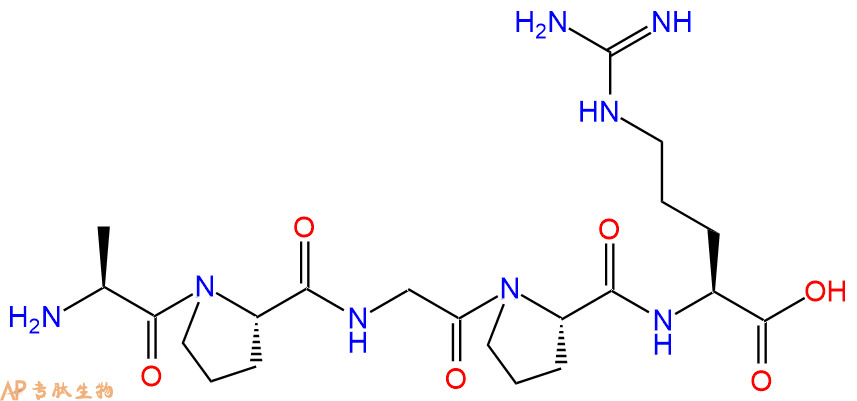
| 编号: | 153507 |
| 中文名称: | 肠抑素Enterostatin, human |
| 英文名: | Enterostatin, human |
| CAS号: | 117830-79-2 |
| 单字母: | H2N-APGPR-OH |
| 三字母: | H2N N端氨基:N-terminal amino group。在肽或多肽链中含有游离a-氨基的氨基酸一端。在表示氨基酸序列时,通常将N端放在肽链的左边。 -Ala丙氨酸:alanine。L-丙氨酸的系统命名为(2S)-氨基丙酸,是编码氨基酸,也叫L-α-丙氨酸。符号:A,Ala。D-丙氨酸存在于多种细菌细胞壁的糖肽中。β-丙氨酸是维生素泛酸和辅酶A的组分。 -ProL-脯氨酸:proline。系统命名为吡咯烷-(2S)-羧酸。为亚氨基酸。是编码氨基酸。在肽链中有特殊作用,如易形成顺式的肽键等。符号:P,Pro。 -Gly甘氨酸:glycine。系统命名为 2-氨基乙酸。是编码氨基酸中没有旋光性的最简单的氨基酸,因具有甜味而得名。符号:G,Gly。 -ProL-脯氨酸:proline。系统命名为吡咯烷-(2S)-羧酸。为亚氨基酸。是编码氨基酸。在肽链中有特殊作用,如易形成顺式的肽键等。符号:P,Pro。 -ArgL-精氨酸:arginine。系统命名为(2S)-氨基-5-胍基戊酸。在生理条件下带正电荷,为编码氨基酸。是幼小哺乳动物的必需氨基酸。符号:R,Arg。 -OHC端羧基:C-terminal carboxyl group。在肽或多肽链中含有游离羧基的氨基酸一端。在表示氨基酸序列时,通常将C端放在肽链的右边。 |
| 氨基酸个数: | 5 |
| 分子式: | C21H36N8O6 |
| 平均分子量: | 496.56 |
| 精确分子量: | 496.28 |
| 等电点(PI): | - |
| pH=7.0时的净电荷数: | 1.97 |
| 平均亲水性: | 1.25 |
| 疏水性值: | -1.26 |
| 外观与性状: | 白色粉末状固体 |
| 消光系数: | - |
| 来源: | 人工化学合成,仅限科学研究使用,不得用于人体。 |
| 纯度: | 95%、98% |
| 盐体系: | 可选TFA、HAc、HCl |
| 储存条件: | 负80℃至负20℃ |
| 标签: | 肠抑素(Enterostatins) |
Enterostatin, human, mouse, rat是可以减少脂肪摄入量的五肽。
Enterostatin, human, mouse, rat is a pentapeptide that reduces fat intake.
Definition
Enterostatin is a pentapeptide generated by the action of trypsin on procolipase in the intestinal lumen. Pharmacologic studies have suggested a role for these peptides in appetite regulation and insulin secretion 1.
Related Peptides
Enterostatins belong to a family of peptides (e.g., Val-Pro-Asp-Pro-Arg, VPDPR; Ala-Pro-Gly-Pro-Arg, APGPR; and Val-Pro-Gly-Pro-Arg, VPGPR) derived from the tryptic cleavage of amino-terminal pentapeptide from procolipase 1.
Discovery
In 1993, Mei et al., identified the peptapeptide obtained from the tryptic cleavage of the N-terminal of procolipase and named it enterostatin 2.
Structural Characteristics
Enterostatin structure is highly conserved in evolution, with an amino acid sequence of XPXPR. Three enterostatin sequences, Val-Pro-Asp-Pro-Arg (VPDPR), Val-Pro-Gly-Pro-Arg (VPGPR), and Ala-Pro-Gly-Pro-Arg (APGPR), have been studied extensively and shown to be almost equally effective in their ability to decrease dietary fat preference 3. Modifications in the N-terminus of VPDPR abrogate biological function, other modifications result in retention of biological activity. The importance of the N-terminal residue of enterostatin was investigated by replacing the L-valine with (i) D-valine, (ii) L-tyrosine or (iii) addition of an L-tyrosine to generate the hexapeptide, YVPDPR. Replacement of the N-terminal L-valine residue with D-valine abrogated the insulin inhibitory activity of the peptide. This demonstrates that the N-terminal valine may be necessary for biological function and is consistent with a previous report showing a lack of effect of D-VPDPR on high-fat food consumption 4.
Mode of Action
A high-fat diet easily promotes hyperphagia giving an impression of an uncontrolled process. Fat digestion itself however provides control of fat intake through the digestion, carried out by pancreatic lipase and its protein cofactor colipase, and through enterostatin, released from procolipase during fat digestion 5. Neural mechanisms arising from the intestine involving vagal afferent nerves may be important for the early satiety mechanism induced by enterostatin during a meal 6. Enterostatin acts through an opioid pathway, rather as a µ-antagonist acting antagonistic to ß-casomorphin. In its mechanism of action enterostatin gives an exothermic reaction, while the opiate has an endothermic reaction. The decreased thermogenesis by opiates could explain an increased appetite and body weight, while an increased thermogenesis by enterostatin could explain a reduction in appetite and loss of body weight. The hypocholesterolemic effects of APGPR and VPDPR are mediated by a CCK1 receptor-dependent mechanism 7.
Functions
Enterostatin released from the exocrine pancreas and gastrointestinal tract, selectively inhibits fat intake through activation of an afferent vagal signaling pathway 8. Recent studies indicate that enterostatin modulates insulin release in response to a variety of agents that affect first phase as well as the second phase of insulin release 4.
References
1. Imamura M, Sumar N, Hermon-Taylor J, Robertson HJ, Prasad C (1998). Distribution and characterization of enterostatin-like immunoreactivity in human cerebrospinal fluid. Peptides, 19(8):1385-1391.
2. Mei J, Bowyer RC, Jehanli AMT, Patel G, Erlanson-Albertsson C (1993). Identification of enterostatin, the pancreatic procolipase activation peptide in the intestine of rat. Pancreas, 8:488-493.
3. Prasad C, Imamura M, Debata C, Svec F, Sumar N, Hermon-Taylor J (1999). Hyper- enterostatinemia in Premenopausal Obese Women. J Clin Endocrinol Metab., 84(3):937-941.
4. Tadayyon M, Liou S, Briscoe CP, Badman G, Eggleston DS, Arch JRS, York DA (2002). Structure-function studies on enterostatin inhibition of insulin release. Int J Diabetes & Metabolism., 10:14-21.
5. Berger K, Winzell MS, Mei J, Erlanson-Albertsson C (2004). Enterostatin and its target mechanisms during regulation of fat intake. Physiol Behav., 83(4):623-630.
6. Mei J, Sörhede-Winzell M, Erlanson-Albertsson C (2002). Plasma Enterostatin: Identification and Release in Rats in Response to a Meal. Obes Res., 10(7):688–694.
7. Takenaka Y, Shimano T, Mori T, Hou IC, Ohinata K, Yoshikawa M. (2008). Enterostatin reduces serum cholesterol levels by way of a CCK1 receptor-dependent mechanism. Peptides.,29(12):2175-2178.
8. Lin L, Thomas SR, Kilroy G, Schwartz GJ, York DA (2003). Enterostatin inhibition of dietary fat intake is dependent on CCK-A receptors Am J Physiol Regul Integr Comp Physiol., 285(2):321-328.
| DOI | 名称 | |
|---|---|---|
| 10.1016/j.peptides.2006.11.003 | Enterostatin (APGPR) enhances memory consolidation in mice | 下载 |
| 10.1016/0928-4257(93)90016-m | Enterostatin: a gut-brain peptide regulating fat intake in rat | 下载 |
| 10.2337/diab.45.9.1157 | Effect of enterostatin on insulin, glucagon, and somatostatin secretion in the perfused rat pancreas | 下载 |
| 10.1002/j.1550-8528.1997.tb00565.x | Enterostatin--a peptide regulating fat intake | 下载 |
多肽H2N-Ala-Pro-Gly-Pro-Arg-COOH的合成步骤:
1、合成CTC树脂:称取2.81g CTC Resin(如初始取代度约为0.4mmol/g)和1.35mmol Fmoc-Arg(Pbf)-OH于反应器中,加入适量DCM溶解氨基酸(需要注意,此时CTC树脂体积会增大好几倍,避免DCM溶液过少),再加入3.37mmol DIPEA(Mw:129.1,d:0.740g/ml),反应2-3小时后,可不抽滤溶液,直接加入1ml的HPLC级甲醇,封端半小时。依次用DMF洗涤2次,甲醇洗涤1次,DCM洗涤一次,甲醇洗涤一次,DCM洗涤一次,DMF洗涤2次(这里使用甲醇和DCM交替洗涤,是为了更好地去除其他溶质,有利于后续反应)。得到 Fmoc-Arg(Pbf)-CTC Resin。结构图如下:
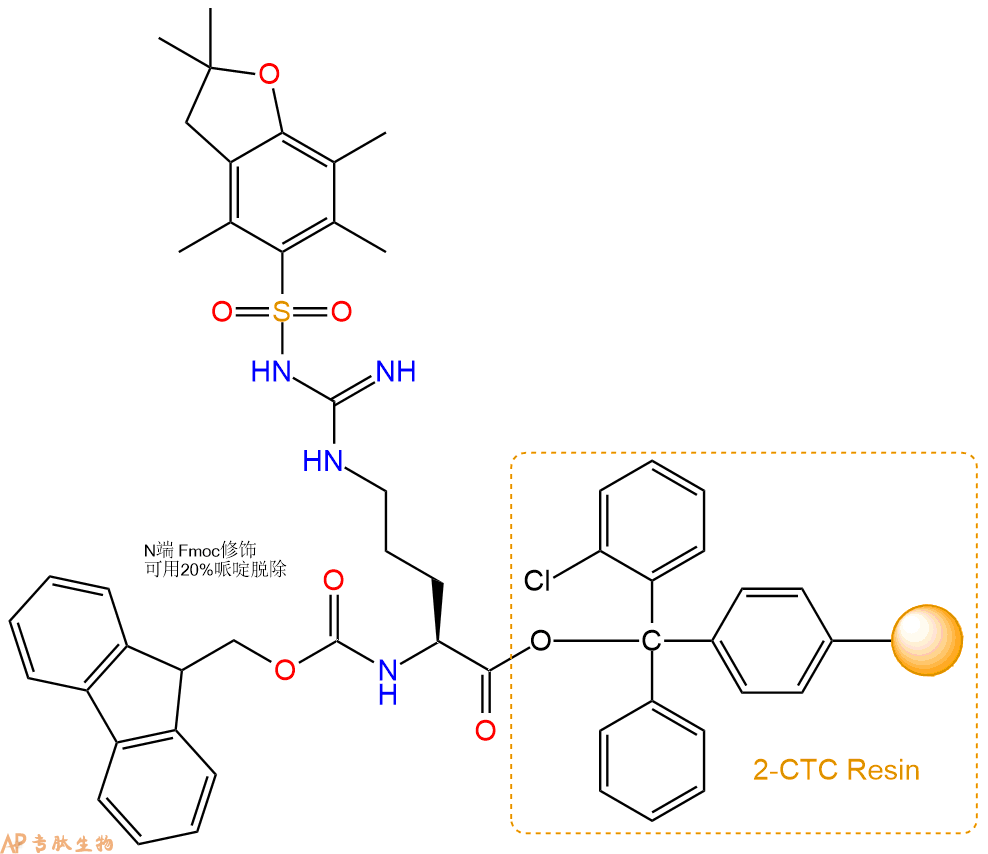
2、脱Fmoc:加3倍树脂体积的20%Pip/DMF溶液,鼓氮气30分钟,然后2倍树脂体积的DMF 洗涤5次。得到 H2N-Arg(Pbf)-CTC Resin 。(此步骤脱除Fmoc基团,茚三酮检测为蓝色,Pip为哌啶)。结构图如下:
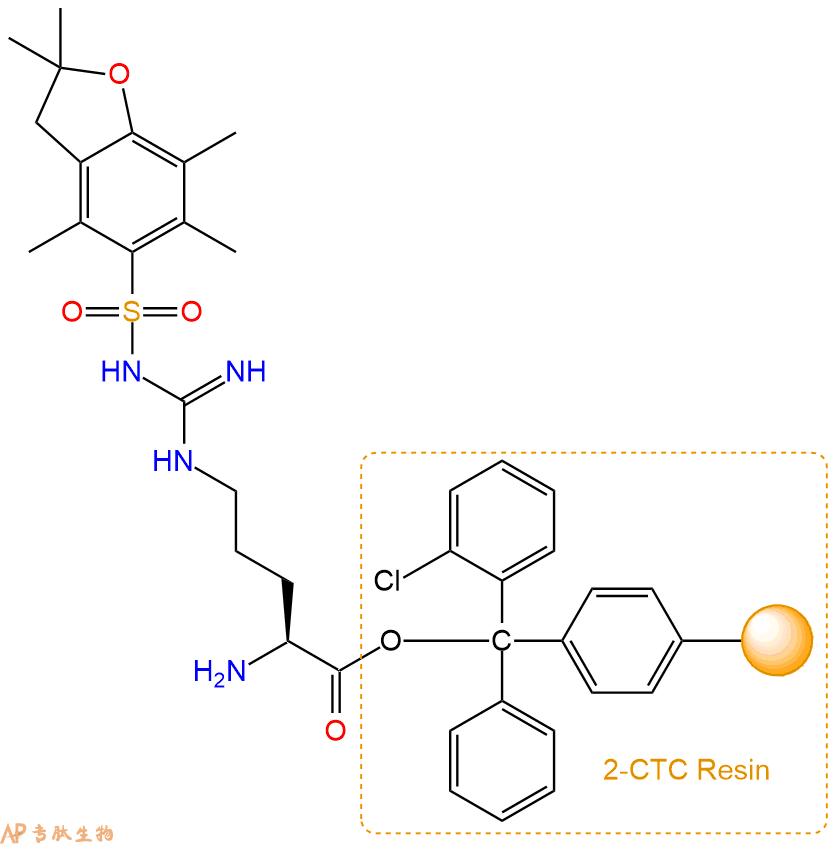
3、缩合:取3.37mmol Fmoc-Pro-OH 氨基酸,加入到上述树脂里,加适当DMF溶解氨基酸,再依次加入6.74mmol DIPEA,3.2mmol HBTU。反应30分钟后,取小样洗涤,茚三酮检测为无色。用2倍树脂体积的DMF 洗涤3次树脂。(洗涤树脂,去掉残留溶剂,为下一步反应做准备)。得到Fmoc-Pro-Arg(Pbf)-CTC Resin。氨基酸:DIPEA:HBTU:树脂=3:6:2.85:1(摩尔比)。结构图如下:
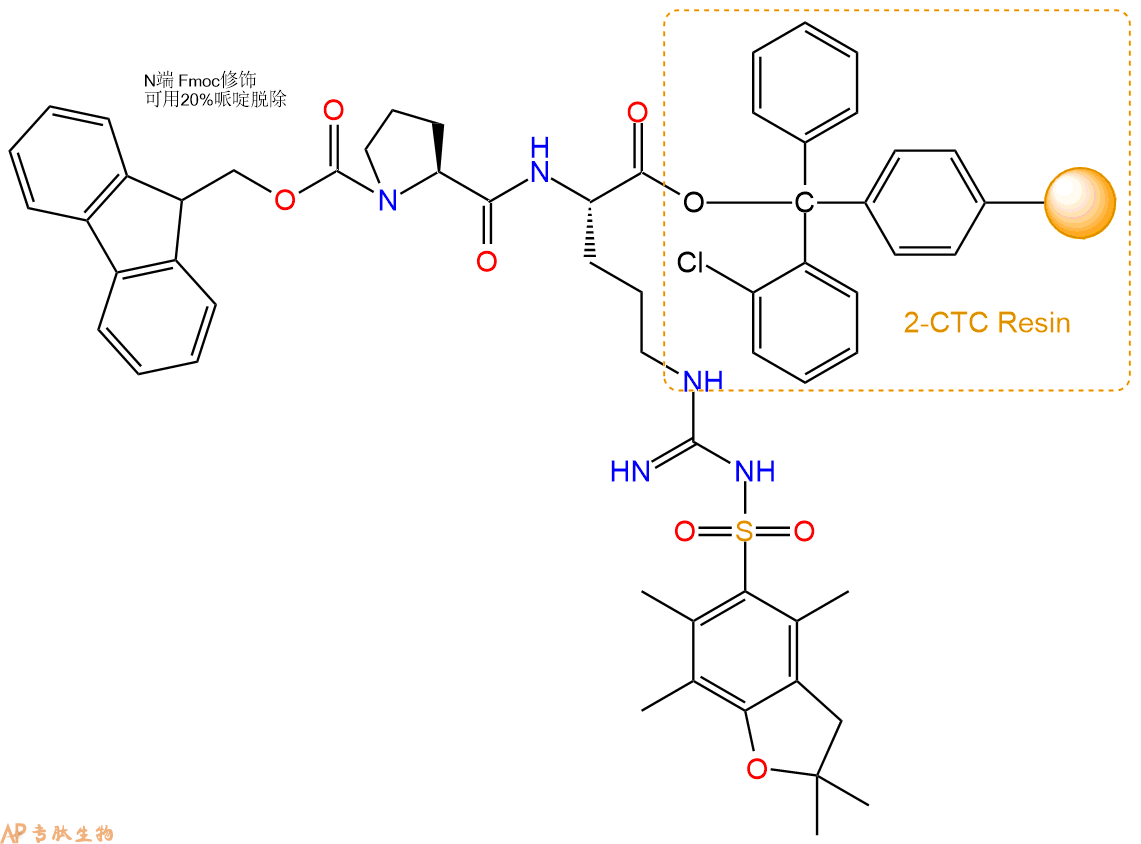
4、依次循环步骤二、步骤三,依次得到
H2N-Pro-Arg(Pbf)-CTC Resin
Fmoc-Gly-Pro-Arg(Pbf)-CTC Resin
H2N-Gly-Pro-Arg(Pbf)-CTC Resin
Fmoc-Pro-Gly-Pro-Arg(Pbf)-CTC Resin
H2N-Pro-Gly-Pro-Arg(Pbf)-CTC Resin
Fmoc-Ala-Pro-Gly-Pro-Arg(Pbf)-CTC Resin
以上中间结构,均可在专肽生物多肽计算器-多肽结构计算器中,一键画出。
最后再经过步骤二得到 H2N-Ala-Pro-Gly-Pro-Arg(Pbf)-CTC Resin,结构如下:
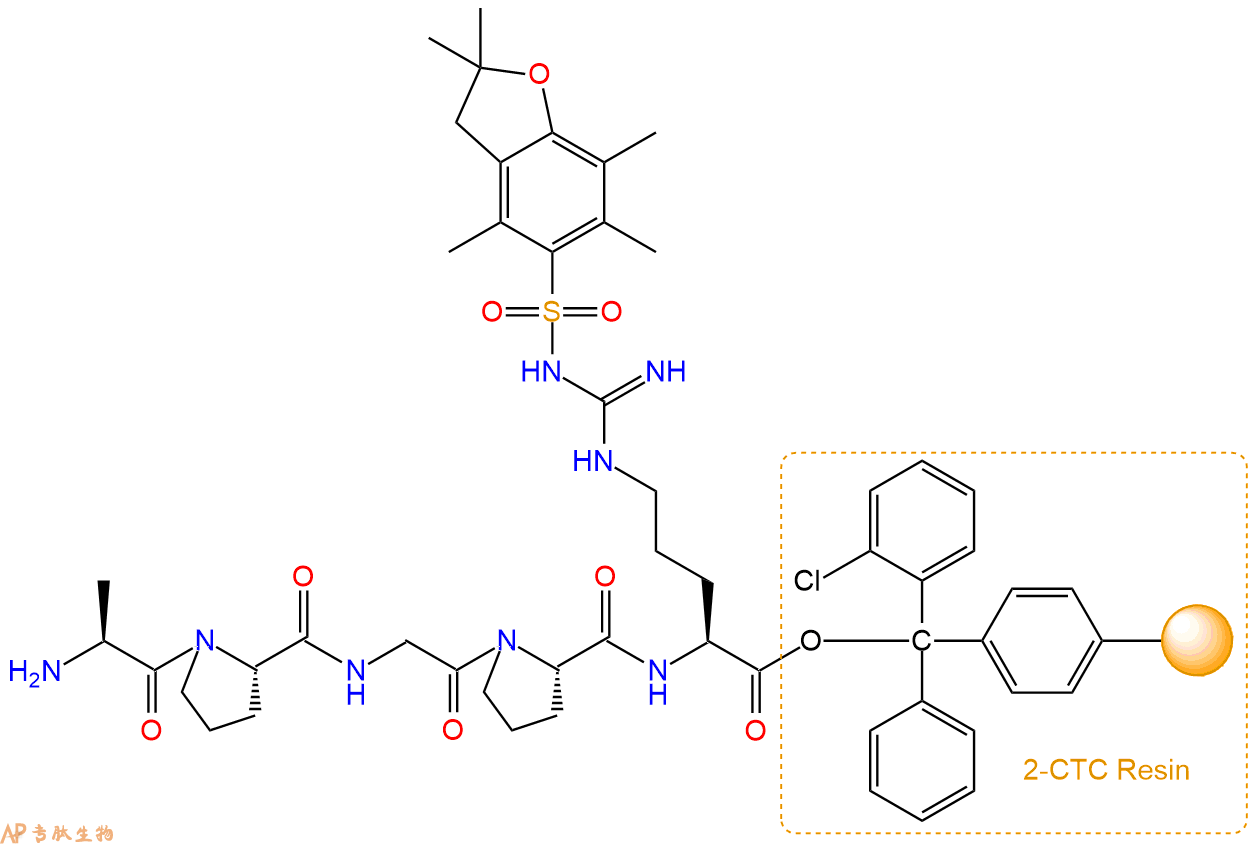
5、切割:6倍树脂体积的切割液(或每1g树脂加8ml左右的切割液),摇床摇晃 2小时,过滤掉树脂,用冰无水乙醚沉淀滤液,并用冰无水乙醚洗涤沉淀物3次,最后将沉淀物放真空干燥釜中,常温干燥24小试,得到粗品H2N-Ala-Pro-Gly-Pro-Arg-COOH。结构图见产品结构图。
切割液选择:1)TFA:H2O=95%:5%、TFA:H2O=97.5%:2.5%
2)TFA:H2O:TIS=95%:2.5%:2.5%
3)三氟乙酸:茴香硫醚:1,2-乙二硫醇:苯酚:水=87.5%:5%:2.5%:2.5%:2.5%
(前两种适合没有容易氧化的氨基酸,例如Trp、Cys、Met。第三种适合几乎所有的序列。)
6、纯化冻干:使用液相色谱纯化,收集目标峰液体,进行冻干,获得蓬松的粉末状固体多肽。不过这时要取小样复测下纯度 是否目标纯度。
7、最后总结:
杭州专肽生物技术有限公司(ALLPEPTIDE https://www.allpeptide.com)主营定制多肽合成业务,提供各类长肽,短肽,环肽,提供各类修饰肽,如:荧光标记修饰(CY3、CY5、CY5.5、CY7、FAM、FITC、Rhodamine B、TAMRA等),功能基团修饰肽(叠氮、炔基、DBCO、DOTA、NOTA等),同位素标记肽(N15、C13),订书肽(Stapled Peptide),脂肪酸修饰肽(Pal、Myr、Ste),磷酸化修饰肽(P-Ser、P-Thr、P-Tyr),环肽(酰胺键环肽、一对或者多对二硫键环),生物素标记肽,PEG修饰肽,甲基化修饰肽
以上所有内容,为专肽生物原创内容,请勿发布到其他网站上。





